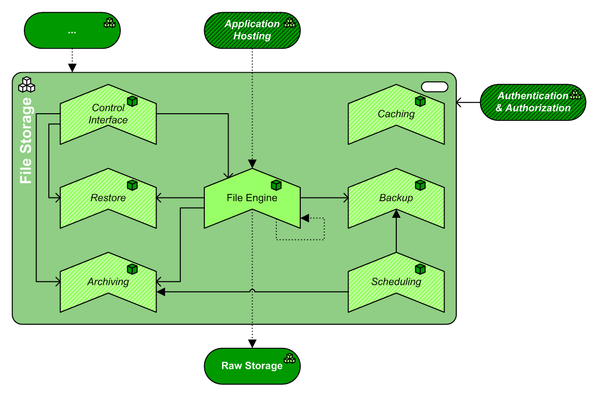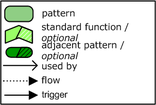PAT.File Storage

|
PAT | File Storage | Version: | 0.4 | 
|
|---|---|---|---|---|---|
| Document type: | Pattern Type | Owner: |

Description
This Pattern Type belongs to "Infrastructure Sector Core". This facility offers data preservation and data retrieval functionality with the following characteristics:
- operates on data at the "loosely structured data" level, e.g. files or documents,
- located at one logical location,
- may offer the ability to perform storage related "intelligent" tasks, such as replication, migration, encryption, compression and data deduplication. This intelligence may be characterized as
- "back-end facing" intelligence; functionality that the facility's users don't get (direct) access to, only the administrators and back-end systems;
- "front-end facing" intelligence; functionality that the facility's users can access and make use of.
Note that File Storage is always implemented on top of some form of Raw Storage. As a consequence, a Pattern Variant dealing with file storage is often based on both the File Storage Pattern Type and the Raw Storage Pattern Type.
As examples: realizations of File Storage (and Raw Storage under it) can include:
- Content Management Systems (CMS) and alike solutions,
- (the front-end of) NAS appliances,
- file share servers.
Note: it's possible that the solution is to make use of Business Rules (e.g. for data deduplication or automatic migration of data to nearline/offline storage). If this is the case, then this pattern must be paired with facilities that deliver this functionality.
Graphical Overview
This is the graphical representation of the infrastructure functions in this Pattern Type, plus their main relations:


(The source file of this picture can be downloaded here).
Pattern Type Composition
This pattern has the following mandatory and optional subfunctions, expressed in Building Block Types:
| Icon | Function | WA | Inclusion | Rationale |
| File Engine | SE | mandatory | This facility handles the actual storing/retrieving of loosely structured data such as (but not restricted to) files or documents. It serves end-users and systems (amongst which application engines and structured data stores). To that end, this facility offers a storage structure that fits the data to be stored, such as a file system for files, and an interface over which data can be offered or retrieved. The File Engine provides "intelligence" to the file storage solution with respect to its handling of the stored data, with the aim of meeting the quality requirements, improving infrastructure management, and/or providing sufficient performance. It may handle migration/replication to other instances of itself, encryption, compression, de-duplication and other "standard" storage-related processing. It also can handle granular, file-based permissions. | |
| Caching | MW | optional | An intelligent storage facility may use caching to increase its capacity to receive and/or return data on request. | |
| Control Interface | SE | optional | If implemented, this function can be used for several Management Tasks, among others:
Care must be taken to limit access to these management tasks to authorized systems and users. | |
| Restore | ST | optional | Implementing a facility of this type may serve different goals:
To support these goals, Restore can support the following activities:
Note that the Restore function may or may not be under control of end users. | |
| Backup | ST | optional | Implementing a facility of this type always serves to support the Restore function, and thus virtually always appears together with one or more Variants of the Restore function. Furthermore, the criteria that govern the Backup functionality must always be derived from the goals and needs of all of the Restore Variants that it supports. Note that the Backup function usually is under control of IT Operations, but may occasionally be offered to end users directly. | |
| Archiving | ST | optional | Implementing a facility of this type in a File Storage Pattern Variant may serve different goals
To support these goals, Archiving offers to perform the following activities:
When the data has been created in the secondary location ("the archive"), it is accessible via a File Engine instance, often one that's either explicitly implemented for the archive. | |
| Scheduling | MW | optional | If the Pattern is to have automated backup and/or archiving functionality, then this function will govern the respective schedules and initiate separate backup and/or archiving jobs. |
Pattern Type Neighbors
This pattern has the following mandatory and optional relations with adjacent (sub)functions, expressed in Pattern Types (PAT). Note: if the table below is empty, then there are no architecturally prescribed relations with adjacent subfunctions:
| Function | Adjacency | Description |
| Raw Storage | mandatory | All "loosely structured data" eventually will have to be stored on some physical device, where it's "raw bits". Putting this Pattern under the File Storage pattern delivers this ability. |
| Authentication & Authorization | optional | A&A will be required for one or more of the following uses:
|
| Application Hosting | optional | One of the facilities that require use of file storage is the Application Hosting facility. An Application Hosting facility requires File Storage to store the applications themselves, and possibly the data with which the applications interact. |
Pattern Variants based on this type
| Pattern Variant | Brief description | Owner | maturity |
|---|---|---|---|
| PAV.File Storage.Local | File Storage.Local | J.A.H. Schoonderbeek | 1 |